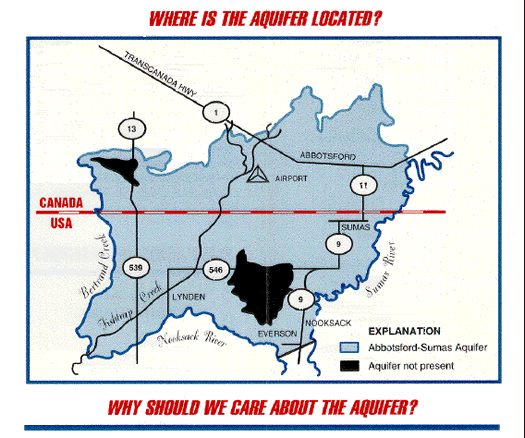Abbotsford-Sumas Aquifer International Task Force
|
Protecting Ground Water for Future Generations Through Internationally Coordinated Management
|
Mission Statement
Recognizing the immediacy of the issues, the mission of the Task Force is to coordinate efforts directed towards protecting the aquifer across the common border between Canada and the United States. These efforts will establish a managerial approach, develop aquifer management strategies, and facilitate coordinated mechanisms to educate and involve the public in protecting the Aquifer's water quality and water resource values.
What is the Abbotsford-Sumas Aquifer?
The aquifer is an underground store-house of water that is used by over 100,000 people in B.C. and Washington, covering 260 sq km (100 sq miles). This water, called ground water, is located in coarse sands and gravel in the Abbotsford, Sumas, and Lynden areas (see map). The ground water flows south from B.C. to Washington.
The aquifer is easily contaminated from surface activities for several reasons. There is only a thin layer of soil at the surface to stop contaminants from moving down into the ground water. Once past this layer, contaminants move easily through the very permeable sands and gravel into this ground water.
Because the water table is close to the surface, surface contaminants do not have very far to travel. The water table is just 0 to 5 metres (15 feet) below the surface at the edges of the aquifer. At the central portion, it is at most 30 or more metres (100 or more feet) below the surface.
To make matters worse, the high annual rainfall (100 - 150 cm or 40 - 60 inches) washes contaminants down into the ground water in a process called leaching. Too much irrigation also contributes to this problem.
Where is the Aquifer Located?

Why Should We Care About the Aquifer?
- The aquifer is the only source of water for thousands of people.
- Ground water is used for drinking, agriculture (animals and irrigation), and industry.
- Ground water quality in the aquifer is being degraded.
- Nitrate contamination of the ground water is getting worse.
Preventing ground water contamination is essential. Cleaning up ground water is more expensive and more difficult than prevention and may not be possible.
What are the Threats?
In recent studies, nitrates have been detected in many wells in the aquifer at concentrations above the standard set by health officials.
Pesticides and volatile organic compounds (VOCs) have also been detected but at concentrations well below the health standards. VOCs such as degreasers and solvents are usually used in industrial practices.
There are numerous potential sources of contamination including:
- agricultural handling of manure
- fertilizer use
- pesticide use
- septic systems
- fuel storage tanks
- surface mining activities
- stormwater runoff
- industrial activities
- urban gardening practices
Intensive agriculture production, expansion of industrial and commercial activities, and rapid urban development increase the potential for future ground water contamination. This growth also increases the importance of this ground water as a source of water.
Abbotsford-Sumas Aquifer International Task Force
To address these Issues, the 1992 Environmental Cooperation Agreement between British Columbia and Washington created a Task Force to coordinate ground water protection efforts in the aquifer region.
The Task Force is developing a joint ground water management plan to ensure a safe and sustainable aquifer and water supply.
The Task Force has:
- defined the aquifer in terms of size, shape, catchment area, hydrologic and hydrogeologic boundaries
- determined land use issues and applicable legislation
- identified and summarized water resource issues
- identified health issues
- received available technical data
- identified educational needs
Three working groups have been established to provide management strategies:
- Information Development and Coordination
- Management of Activities Threatening the Aquifer
- Legislation and Policy Advice
Members of the Task Force
BRITISH COLUMBIA
Federal and Provincial Agencies
- Agriculture and Agri-Food Canada
- Environment Canada
- Health Canada
- Ministry of Agriculture and Lands
- Ministry of Environment
- Ministry of Healthy Living and Sports
Aboriginal
Local Government Agencies
- City of Abbotsford
- Central Fraser Valley Regional District
Non-Governmental Organizations
WASHINGTON
Federal and State Agencies
- U.S. Environmental Protection Agency
- U.S. Natural Resources Conservation Service
- U.S. Geological Survey
- WA Department of Agriculture
- WA Department of Ecology
- WA Department of Health
- WSU Cooperative Extension
Tribal Governments
- Nooksack Indian Nation
- Lummi Indian Nation
Local Government Agencies
- City of Sumas
- Whatcom County
Want More Information
Please contact:
BRITISH COLUMBIA
Ministry of Environment
2rd Floor - 10470 152nd Street
Surrey B.C. V3R 0Y3
Canada
Tel: 604-582-5200
Fax: 604-582-5235
WASHINGTON
Washington State Dept. of Ecology
3190 - 160th Avenue SE
Bellevue Washington USA
98008-5452
Tel: 425-649-7000
Fax: 425-649-7098
|